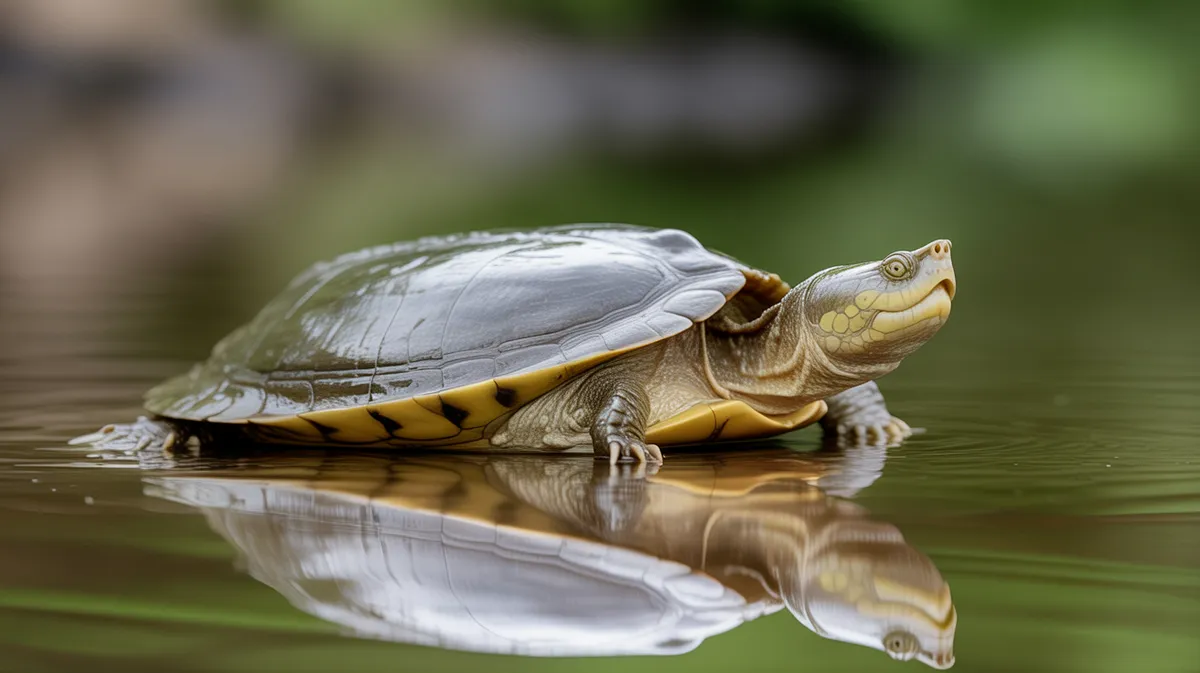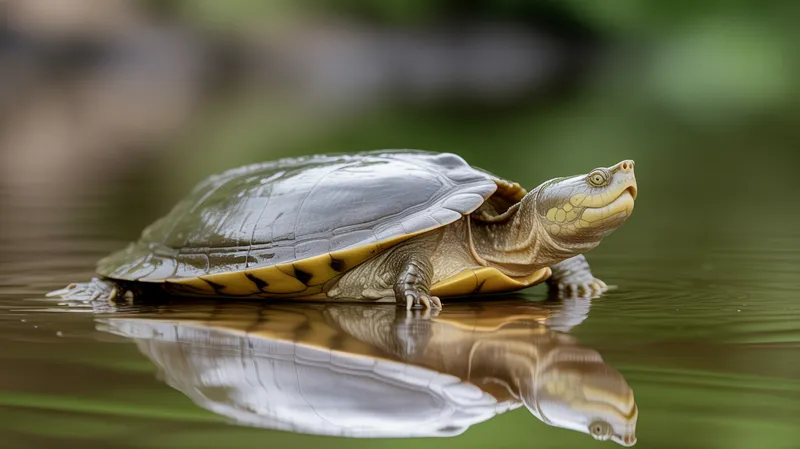
Spiny Softshell Turtle
Apalone spinifera

Meet the Spiny Softshell Turtle
The Spiny Softshell Turtle is a large, aquatic turtle known for its distinctive leathery, pancake-like shell, which lacks the hard scutes seen in most turtles. Its shell is round, flat, and flexible, with small spiny projections along the front edge, especially in juveniles and females. This turtle is highly adapted for life in rivers, lakes, and streams with soft, sandy, or muddy bottoms, where it spends much of its time buried and camouflaged. Agile swimmers, spiny softshell turtles use their webbed feet to move swiftly through water and can remain submerged for long periods by absorbing oxygen through their skin and throat lining.
Classification
Reptile
Habitat
Freshwater rivers, lakes, and streams with sandy or muddy bottoms
Diet
Carnivore
Lifespan
20-50 years
Conservation
Least Concern
Weight
3.0-10.0 kg (6.6-22.0 lbs)
📖Fascinating Facts
Flexible Shell
Unlike most turtles, this species has a soft, leathery shell that allows greater flexibility and faster swimming.
Fast Swimmer
The Spiny Softshell Turtle is one of the fastest-swimming freshwater turtles, using its webbed feet to propel itself rapidly through water.
Snorkel Nose
Its elongated, tubular nose functions like a snorkel, enabling it to breathe while mostly submerged.
📋Detailed Description
The Spiny Softshell Turtle (Apalone spinifera) is a large, highly aquatic turtle distinguished by its flattened, round carapace, which is soft, leathery, and lacks the keratinized scutes typical of most turtles. Adult females are notably larger than males, with carapace lengths reaching up to 48 cm (19 in), while males generally reach 24 cm (9.5 in). The carapace is olive to tan, often with dark spots or blotches, and is edged with small, conical spines, especially pronounced in juveniles and adult females. The plastron is pale and unmarked. The head is elongated with a tubular, snorkel-like snout and prominent nostrils, aiding in aquatic respiration. Limbs are fully webbed and powerful, enabling swift swimming and rapid burrowing into soft substrates. Eyes are positioned dorsally, allowing the turtle to remain mostly submerged and concealed while observing its surroundings. Spiny softshells are primarily diurnal, basking on sandbars or logs but quickly retreating to water when disturbed. They are solitary outside of the breeding season and exhibit a cryptic lifestyle, spending much time buried with only their eyes and snout exposed.
💡 Did you know?
Unlike most turtles, the Spiny Softshell Turtle can bury itself completely in sand or mud, leaving only its nose exposed to ambush prey and avoid predators.
🔬Research & Sources
Wikipedia Summary
The spiny softshell turtle is a species of softshell turtle, one of the largest freshwater turtle species in North America. Both the common name, spiny softshell, and the specific name, spinifera (spine-bearing), refer to the spiny, cone-like projections on the leading edge of the carapace, which are not scutes (scales).
Last Modified: 6/9/2025
🎭Behavior & Social Structure
Spiny Softshell Turtles are opportunistic carnivores, feeding on a wide variety of aquatic invertebrates (insects, crayfish, mollusks), small fish, amphibians, and occasionally carrion. They employ both active hunting and ambush tactics, often lying buried in sand or mud and lunging at passing prey. Their long necks and rapid strike speed aid in capturing elusive prey. These turtles are highly wary, with acute vision and sensitivity to vibrations, making them difficult to approach in the wild. They bask frequently to regulate body temperature but are quick to dive and bury themselves when threatened. Social interactions are minimal, with individuals maintaining territories and only coming together during the breeding season. Juveniles are more vulnerable to predation and tend to be more secretive. Nocturnal activity is rare, though some feeding may occur at dawn or dusk.
👶Reproduction & Life Cycle
Breeding occurs in late spring to early summer (May–July), with males actively seeking out and courting females through tactile and visual displays. Mating takes place in shallow water. Females lay 4–38 spherical, leathery eggs per clutch, typically in sandy or gravelly banks above the flood line. Nesting occurs at night or early morning, and females may lay multiple clutches per season. Incubation lasts 55–90 days, depending on temperature and latitude. Hatchlings emerge in late summer or early fall, measuring about 2.5–3.5 cm (1–1.4 in) in carapace length. There is no parental care; hatchlings are independent from birth. Temperature-dependent sex determination occurs, with warmer nest temperatures generally producing more females.
🛡️Adaptations & Survival
The Spiny Softshell Turtle exhibits several unique adaptations for an aquatic lifestyle. Its flattened, flexible shell reduces drag and allows for rapid burrowing into soft substrates for camouflage and predator avoidance. The skin, especially on the throat and cloaca, is highly vascularized, enabling cutaneous and pharyngeal respiration—allowing the turtle to remain submerged for extended periods, even in low-oxygen environments. The tubular snout functions as a snorkel, permitting breathing while the body remains hidden. Webbed feet with long claws facilitate powerful swimming and digging. Their cryptic coloration and behavior minimize predation risk. Rapid growth rates in juveniles help reduce vulnerability to predators.
📚Research Sources
🎨Cultural Significance
Spiny Softshell Turtles have limited direct cultural significance compared to other North American turtles, but they are occasionally featured in indigenous folklore and regional stories, often symbolizing adaptability or stealth. In some areas, they have been harvested for food or traditional medicine, though this is less common today. Their unusual appearance and behavior make them subjects of interest for naturalists and educators, and they are sometimes kept in public aquaria. They also play a role in local ecosystems as both predator and prey, contributing to aquatic biodiversity.
🔬Recent Research & Discoveries
Recent research has focused on the species’ remarkable respiratory adaptations, including the ability to absorb oxygen through the skin and lining of the throat and cloaca, which is being studied for insights into vertebrate respiration. Genetic studies have clarified the relationships among subspecies and their distribution, with ongoing work on hybridization and population structure. Ecological studies have examined the effects of river modification and pollution on population dynamics. Conservation research is investigating the impacts of road mortality and climate change on nesting success and sex ratios. Some studies are exploring the turtle’s microbiome and resistance to pathogens, which may have implications for conservation management.
🎥Wildlife Videos

Just Turtles: Exploring the Lives of Ancient Reptile | Full Documentary
When spent in the company of Turtles, life in the slow lane is a fascinating ride. JUST TURTLES takes an in-depth look at these ...
Get.factual

Nature Nuggets: Eastern Spiny Softshell Turtles
Sara has a passion for turtles - and would like to teach you about one of her favourites: The Spiny Softshell Turtle! To stay ...
Rondeau Provincial Park

The Spiny Softshell Turtle: Ontario Wildlife Video Series
Educational video of the Spiny Softshell Turtle (Apalone spinifera) and its conservation in Ontario, Canada. Filmed, edited, and ...
Ryan M. Bolton

How Turtles Survive In The Wild (Wildlife Documentary) | Wild About
There's more to the turtle than meets the shell. Join us as we slow things down and see the world through the eyes of these ...
Real Wild

Softshell Turtle Rescue - Mini Documentary
Large Florida Softshell Turtle had clawed her way under the front gate to the backyard patio tearing the leather-like soft shell in the ...
MyBackyardBirding

Releasing Spiny Softshell Turtles
Volunteer Lara Kirk reflects on her experience volunteering with the UTRCA's Species at Risk Program.
UTRCA
🌍Habitat Information
The Spiny Softshell Turtle typically inhabits Freshwater rivers, lakes, and streams with sandy or muddy bottoms environments. Spiny Softshell Turtles have adapted to their environments with specialized features and behaviors.
Primary Habitat:
Freshwater rivers, lakes, and streams with sandy or muddy bottoms
More detailed habitat information will be available soon.
🛡️Conservation Status
The Spiny Softshell Turtle is currently classified as Least Concern. Conservation efforts are crucial for preserving this species for future generations.
Common Threats:
- 🏠Habitat loss and fragmentation
- 🌡️Climate change impacts
- 🎯Hunting and poaching
- 🏭Human-wildlife conflict
⚠️Threats & Conservation Challenges
Although currently listed as Least Concern, Spiny Softshell Turtles face several threats. Habitat loss and degradation from river channelization, damming, pollution, and shoreline development reduce suitable nesting and foraging areas. Water pollution, especially from agricultural runoff and heavy metals, can impact health and reproductive success. Road mortality during nesting migrations is a significant threat to females. Collection for the pet trade and local consumption persists in some areas. Predation by raccoons, skunks, and birds affects eggs and juveniles. Climate change may alter sex ratios and nesting success due to temperature-dependent sex determination. Despite these challenges, populations remain stable in many regions, but local declines have been documented.
🔬Scientific Classification
Scientific Name
Apalone spinifera
Classification Hierarchy
🔍 About Taxonomic Classification
Taxonomic classification is a hierarchical system used by scientists to classify and organize living organisms based on shared characteristics and evolutionary relationships.
The system moves from broad categories (Kingdom) to increasingly specific ones, with each animal's scientific name typically consisting of its Genus and species.
📝Community Notes
Share your observations and insights about the Spiny Softshell Turtle with our community of wildlife enthusiasts.
Join Our Community
Sign in to share your observations and connect with fellow wildlife enthusiasts.
Sign In to ContributeNo community notes yet
Be the first to share your observations about the Spiny Softshell Turtle!
Explore Spiny Softshell Turtle
Select a tab above to learn more about this amazing animal.
📸Photo Gallery
No photos available for this animal yet.
🌟Discover More Wildlife
Continue your journey of discovery with more fascinating animals from our database
